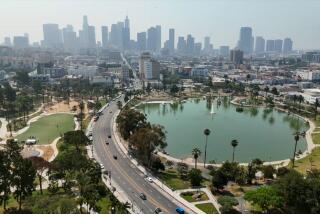Op-Ed: The philosophy that has pitted cars against cyclists for the last 40 years is finally dying
- Share via
Take a ride on downtown L.A.’s first major protected bike lane and you’re rolling over something more than asphalt and paint: the symbolic end to vehicular cycling, an idea that dominated American urban bicycle advocacy for nearly 40 years.
In his influential 1976 book “Effective Cycling,” Californian John Forester argued that cyclists “fare best when they act and are treated as drivers of vehicles.” In Forester’s paradigm, this means cyclists shouldn’t cower in the gutters, but should assert their place in the middle of a lane, where they should be afforded equal treatment by operators of motor vehicles — and the law.
Cyclists and bike lobbyists latched on to Forester’s ideas to the point where the phrase “taking the lane,” became a rallying cry. The law in most places still required cyclists to ride as far to the right as practicable, but adherents of vehicular cycling claimed their space on roads, bravely arm-signalling their left turns. Everyone’s seen that guy clad in Lycra, riding his bike in front of a line of cars, seemingly impervious to the horns blasting behind him.
In Forester’s paradigm, cyclists shouldn’t cower in the gutters ... [they] should be afforded equal treatment by operators of motor vehicles — and the law.
Other countries, however, took a different approach — one which, over time, has proved far superior.
Back when Forester’s ideas were first starting to spread in the United States, planners in Amsterdam and Copenhagen responded to a grassroots movement against the motor-vehicle takeover of their streets by building separate lanes for bikes, blissfully segregated from bus and auto traffic by a physical partition. The result wasn’t just more people riding bikes, it was more people of different types riding bikes: not just the courageous and athletic who tended to embrace vehicular cycling, but children and the elderly.
Advocates in Montreal took note, and after some creative lobbying — including a now-famous die-in that stopped traffic on a busy thoroughfare — the city built its first segregated bike lane more than 30 years ago. Today, Montreal is still building such lanes, and the presence of thousands of daily cyclists puts up a good argument in favor of it being the most bike-friendly city on the continent. A recent report found that the number of trips made by bicycle for transportation increased by 57% between 2008, when it was already among the highest in North America, and 2013.
The contrasts are stark between cities that embraced bike-car segregation and those where vehicular cycling lingered the longest. With little separated infrastructure in L.A., the number of bicycle commuters in the city has barely budged in the last decade, hovering at around 19,000, according to the 2014 federal census. Montreal, meanwhile, has about 24,000 daily commuters, according to a recent report by Velo Quebec, despite a population less than half that of L.A. and a climate much less friendly to cycling. The only North American city with more cyclists than Montreal is New York, with a population four times its size.
The growth of cycling in New York is its own study in the benefits of bike-specific infrastructure. A boom in the construction of protected bike lanes over the last decade helped lead to a tripling in the number of bike trips made in the city since 2000.
What would-be cyclists respond to is safety, or at least the perception of it. Most people, when presented with the idea of “bicycle driving,” as Forester sometimes called it, choose not to ride at all. Safety concerns also help explain why simple painted bike lanes have failed to attract cyclists in large numbers. For many tentative cyclists, only a physical separation from moving automobiles can make them feel secure.
From a distance, it’s obvious the notion of vehicular cycling was misguided. Not only did Forester’s theory put cyclists in harm’s way, it generated anger among motorists and taught them to see bikes as nuisances. This enmity, in turn, arguably hamstrung local governments’ efforts to build more and safer infrastructure.
Forester, meanwhile, continues to argue against separated bike lanes, saying it reduces cyclists to begging for scraps of infrastructure, reinforces perceptions of cycling as inferior, and fills the streets with poorly skilled cyclists. Indeed, some of the most vociferous opponents of bike lanes are vehicular cyclists, who say becoming part of traffic isn’t as difficult as it’s perceived to be.
For individuals, there’s still merit in the practical principles of vehicular cycling: If you’re riding a bike in Los Angeles — or pretty much anywhere in the United States — you’re going to have to make a left turn on a busy road eventually. But vehicular cycling had 40 years to prove itself, and it’s now time to move on. More and more, that means moving on a separated bike lane.
Tom Babin is the author of “Frostbike: The Joy, Pain and Numbness of Winter Cycling.” He blogs about bikes at shifter.info.
Follow the Opinion section on Twitter @latimesopinion and Facebook
ALSO
How I learned to bike to work in Los Angeles without getting maimed
Hey, L.A. drivers: Don’t honk at bike riders
More to Read
A cure for the common opinion
Get thought-provoking perspectives with our weekly newsletter.
You may occasionally receive promotional content from the Los Angeles Times.










